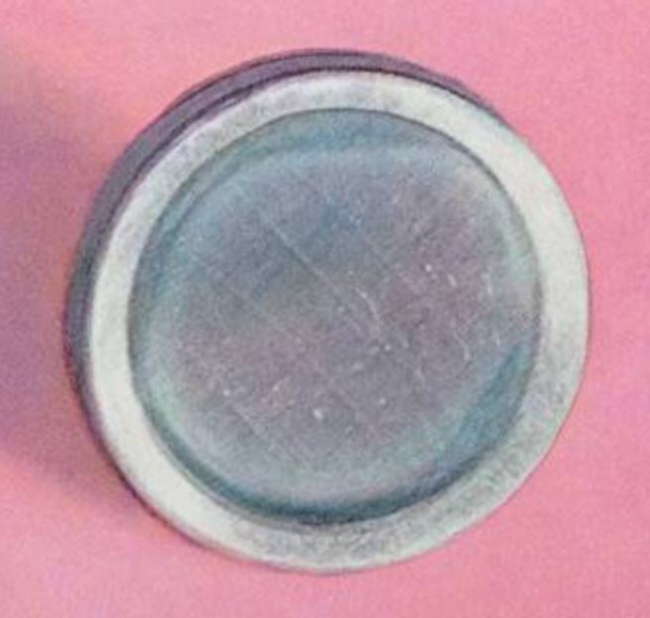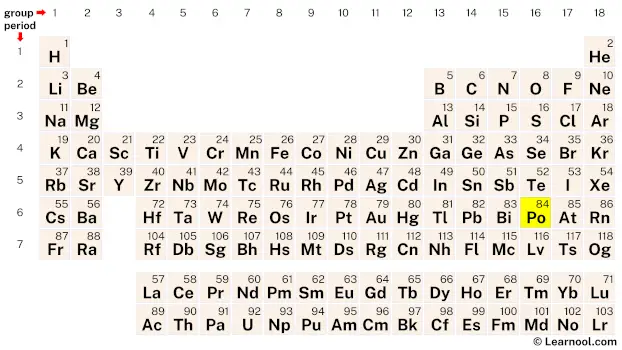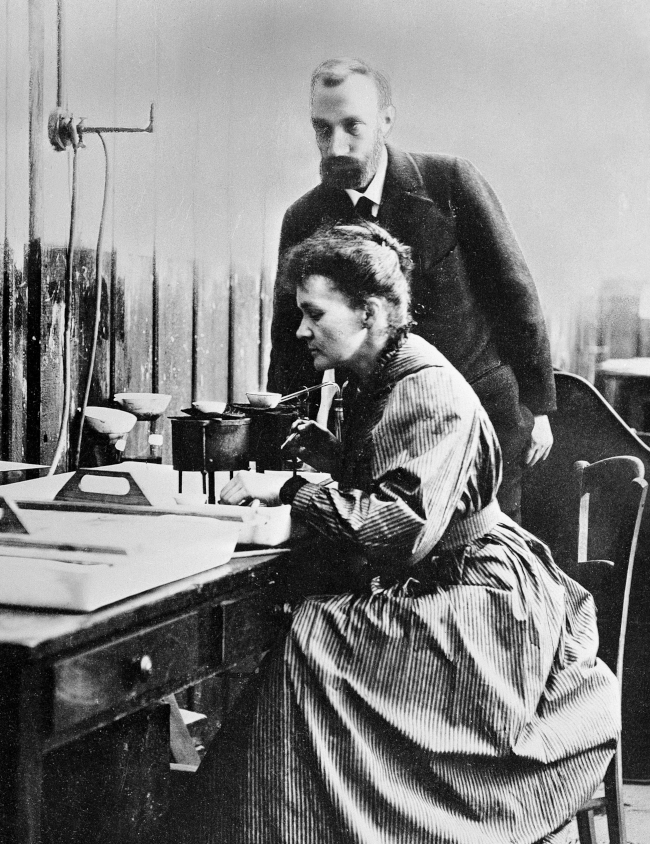
Polonium (Po) is a chemical element of the periodic table, located in the group 16 and the period 6, and has the atomic number 84. It is a rare, silvery-grey or black post transition metal, which is named after Poland, homeland of Marie Curie. It is highly toxic and is counted as one of the radioactive elements. It is a member of the chalcogen group.
On periodic table
| group | ⇨ | 1 | 2 | 3 | 4 | 5 | 6 | 7 | 8 | 9 | 10 | 11 | 12 | 13 | 14 | 15 | 16 | 17 | 18 |
| period | ⇩ | ||||||||||||||||||
| 1 | 1 H  Hydrogen |
2 He  Helium |
|||||||||||||||||
| 2 | 3 Li  Lithium |
4 Be  Beryllium |
5 B  Boron |
6 C  Carbon |
7 N  Nitrogen |
8 O  Oxygen |
9 F  Fluorine |
10 Ne  Neon |
|||||||||||
| 3 | 11 Na  Sodium |
12 Mg  Magnesium |
13 Al  Aluminium |
14 Si Silicon |
15 P  Phosphorus |
16 S  Sulfur |
17 Cl  Chlorine |
18 Ar  Argon |
|||||||||||
| 4 | 19 K  Potassium |
20 Ca  Calcium |
21 Sc  Scandium |
22 Ti  Titanium |
23 V  Vanadium |
24 Cr  Chromium |
25 Mn  Manganese |
26 Fe  Iron |
27 Co  Cobalt |
28 Ni  Nickel |
29 Cu  Copper |
30 Zn  Zinc |
31 Ga  Gallium |
32 Ge  Germanium |
33 As  Arsenic |
34 Se  Selenium |
35 Br  Bromine |
36 Kr  Krypton |
|
| 5 | 37 Rb  Rubidium |
38 Sr  Strontium |
39 Y  Yttrium |
40 Zr  Zirconium |
41 Nb  Niobium |
42 Mo  Molybdenum |
43 Tc  Technetium |
44 Ru  Ruthenium |
45 Rh  Rhodium |
46 Pd  Palladium |
47 Ag  Silver |
48 Cd  Cadmium |
49 In  Indium |
50 Sn  Tin |
51 Sb  Antimony |
52 Te  Tellurium |
53 I  Iodine |
54 Xe  Xenon |
|
| 6 | 55 Cs  Caesium |
56 Ba  Barium |
72 Hf  Hafnium |
73 Ta  Tantalum |
74 W  Tungsten |
75 Re  Rhenium |
76 Os  Osmium |
77 Ir  Iridium |
78 Pt  Platinum |
79 Au  Gold |
80 Hg  Mercury |
81 Tl  Thallium |
82 Pb  Lead |
83 Bi  Bismuth |
84 Po Polonium |
85 At  Astatine |
86 Rn  Radon |
||
| 7 | 87 Fr  Francium |
88 Ra  Radium |
104 Rf  Rutherfordium |
105 Db  Dubnium |
106 Sg  Seaborgium |
107 Bh  Bohrium |
108 Hs  Hassium |
109 Mt  Meitnerium |
110 Ds  Darmstadtium |
111 Rg  Roentgenium |
112 Cn  Copernicium |
113 Nh  Nihonium |
114 Fl  Flerovium |
115 Mc  Moscovium |
116 Lv  Livermorium |
117 Ts  Tennessine |
118 Og  Oganesson |
||
| 57 La  Lanthanum |
58 Ce  Cerium |
59 Pr  Praseodymium |
60 Nd  Neodymium |
61 Pm  Promethium |
62 Sm  Samarium |
63 Eu  Europium |
64 Gd  Gadolinium |
65 Tb  Terbium |
66 Dy  Dysprosium |
67 Ho  Holmium |
68 Er  Erbium |
69 Tm  Thulium |
70 Yb  Ytterbium |
71 Lu  Lutetium |
|||||
| 89 Ac  Actinium |
90 Th  Thorium |
91 Pa  Protactinium |
92 U  Uranium |
93 Np  Neptunium |
94 Pu  Plutonium |
95 Am  Americium |
96 Cm  Curium |
97 Bk  Berkelium |
98 Cf  Californium |
99 Es  Einsteinium |
100 Fm  Fermium |
101 Md  Mendelevium |
102 No  Nobelium |
103 Lr  Lawrencium |
|||||
| – p block |
Polonium is a p-block element, situated in the sixteenth column (oxygen group) of the periodic table, next to bismuth (Bi). Its atomic number is 84 and its symbol is Po.
Element information
 |
|
 |
|
| Origin of name | named after Poland, homeland of Marie Curie |
| Symbol | Po |
| Atomic number (Z) | 84 |
| Atomic mass | (209) |
| Block | p-block |
| Group | 16 (oxygen group) |
| Period | 6 |
| Classification | Post-transition metal |
| Atomic radius | 168 pm |
| Covalent radius | 140±4 pm |
| Van der Waals radius | 197 pm |
| Melting point | 254 ℃, 489 ℉, 527 K |
| Boiling point | 962 ℃, 1764 ℉, 1235 K |
| Electron configuration | [Xe] 4f14 5d10 6s2 6p4 |
| Learn how to write: Polonium electron configuration | |
| Electrons per shell | 2, 8, 18, 32, 18, 6 |
| Crystal structure | Cubic (α-Po) Rhombohedral (β-Po) |
| Phase at r.t | Solid |
| Density near r.t | 9.196 g/cm3 (α-Po) 9.398 g/cm3 (β-Po) |
| Natural occurrence | From decay |
| Oxidation state | +2, +4 |
| Electronegativity (Pauling scale) | 2.0 |
| Protons Neutrons Electrons |
84 125 84 |
| Valence electrons | 6 |
| Learn how to find: Polonium valence electrons | |
| CAS number | 7440-08-6 |
| Discovered by | Pierre and Marie Curie in 1898 |
History

Polonium is a radioactive element that was discovered in 1898 by Marie and Pierre Curie, who were studying the radioactive decay of uranium. They observed that certain minerals, including pitchblende, emitted a type of radiation that was more powerful than what could be explained by the presence of uranium alone. Through a series of experiments, they were able to isolate two new elements from the ore: polonium and radium. Polonium was named after Marie Curie’s native country of Poland.
The discovery of polonium marked an important milestone in the field of radioactivity, as it was the first time a new element had been discovered through its radiation. It also led to important discoveries in nuclear physics and ultimately contributed to the development of nuclear energy.
Occurrence and production
Polonium is a rare radioactive element that is not found naturally in the environment. It can be produced in small quantities through the radioactive decay of other elements, such as uranium and radium.
The main production method of polonium involves bombarding bismuth with neutrons in a nuclear reactor, which creates a small amount of polonium as a byproduct. This method is used to produce polonium for various applications, such as in nuclear batteries, static eliminators, and as a neutron source in research. However, due to the potential health hazards associated with polonium, its production and use are heavily regulated.
Properties
Polonium is a silvery-gray metal that has a radioactive property.
It has 33 isotopes, with Po-209 having the longest half-life of all naturally occurring polonium isotopes at 125 years.
It has a density of 9.196 g/cm3, which makes it one of the densest elements.
Polonium is highly reactive, and it readily combines with other elements, particularly metals, to form compounds.
It emits alpha particles, which can be harmful to living organisms when ingested or inhaled.
Polonium has a melting point of 254 degrees Celsius and a boiling point of 962 degrees Celsius.
It is one of the rarest elements on Earth, and it is mostly produced through the decay of uranium and thorium.
Applications
Polonium has limited practical applications due to its high radioactivity and toxicity.
In the past, polonium-210 has been used as a heat source in satellites and other devices that require a compact, long-lasting source of power.
Due to its ability to generate a stream of alpha particles, polonium-210 has been used as a neutron initiator in nuclear weapons.
Polonium has also been used in certain types of scientific experiments, particularly those involving the study of materials under extreme conditions, such as high pressure or temperature.
In recent years, polonium has gained notoriety due to its use as a poison, notably in the assassination of Russian spy Alexander Litvinenko in 2006.
Interesting facts
Polonium was named after Marie Curie’s homeland, Poland.
It is one of the rarest elements on Earth, and occurs naturally only in trace amounts.
Due to its high radioactivity, it has been used in various ways, such as in static eliminators, as a heat source in satellites, and as a neutron source in nuclear physics research.
Polonium-210 is the most stable isotope of polonium, but it has a half-life of only 138 days.
It played a significant role in the assassination of Russian spy Alexander Litvinenko in 2006.
Related
More elements
External links
- https://www.rsc.org/periodic-table/element/84/polonium
- https://en.wikipedia.org/wiki/Polonium
- https://www.britannica.com/science/polonium
- https://pubchem.ncbi.nlm.nih.gov/element/Polonium
- https://education.jlab.org/itselemental/ele084.html
- https://www.chemicool.com/elements/polonium.html
- https://www.radiochemistry.org/periodictable/elements/84.html
- https://www.livescience.com/39452-polonium.html
Deep
Learnool.com was founded by Deep Rana, who is a mechanical engineer by profession and a blogger by passion. He has a good conceptual knowledge on different educational topics and he provides the same on this website. He loves to learn something new everyday and believes that the best utilization of free time is developing a new skill.
